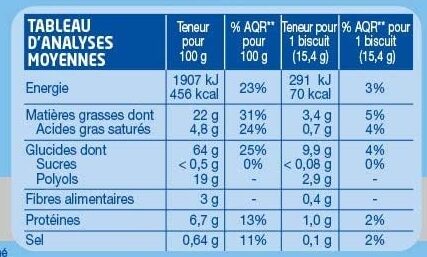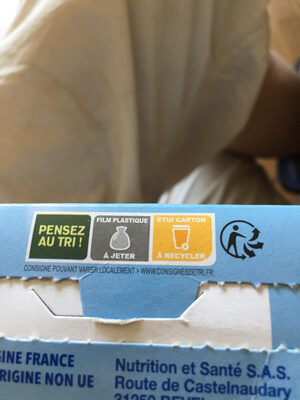Gerblé - Sugar Free Cocoa Filled Cookie, 185g (6.6oz) - 185 g
Barcode: 3175681123014 (EAN / EAN-13)
Common name: Biscuits avec édulcorants fourrés au cacao (5,1%)
Quantity: 185 g
Packaging: Cardboard, fr:Etui en carton, fr:Film en plastique
Brands: Gerblé
Categories: Snacks, Sweet snacks, Biscuits and cakes, Biscuits, Chocolate biscuits, Filled biscuits, fr:Biscuits édulcorés
Labels, certifications, awards:
Sustainable farming, UTZ Certified, Triman, Agriculture durable, Avec édulcorants, Fabriqué en France, Peu ou pas de sucre, Point Vert, Sans huile de palme, Sans sucre

Origin of ingredients: Farine filière durable et locale, Cacao origine non UE
Stores: Magasins U, carrefour.fr
Countries where sold: France, French Polynesia
Matching with your preferences
Report a problem
Data sources
Product added on by openfoodfacts-contributors
Last edit of product page on by kiliweb.
Product page also edited by desan, driveoff, foodvisor, inf, magasins-u, marmotte73, moon-rabbit, packbot, quechoisir, quentinbrd, ramses16, roboto-app, scanbot, tacite, thaialagata, tomao, yuka.R1pva0w3UlJoZnNqZ2NZWS9SelN3NGxvNXJ1V1RWbTFKOU1USWc9PQ, yuka.R3IwTU01a1l1S0lCcXZBMTlRSEgwUHg2NkozMEExdVdFTmRNSVE9PQ, yuka.RzZrbk9hWWJoZUVGd2RneXhUUDM1OVZ0bVp1MWVFSHVHN1FYSVE9PQ, yuka.SHB0WUQvMG9qY1FscGRzRHhVL2Y5NEpQeTYyemZWK1lPK2M4SUE9PQ, yuka.U3FFc0Rwc08vL0EwaXNJWDFVdlAzT0F1bWNhSFpGNkhKK3dMSVE9PQ, yuka.UjRjQktvSS8vZkk3bGZRdXBEWExwZmNxM3BxcFlHQzZPZVlWSWc9PQ, yuka.V1BzbEN2d3JsdVZYcXNjUS9nL0oxZTFlemFTalVVeVRLOFZQSVE9PQ, yuka.VGFVWVRvMWZyT2dFcGNSazN5TE53ZU5KNEtLRWZHSzlEYzRTSWc9PQ, yuka.YTVBTUZ2a1Rndm9IeGYwZ29pSHQ0TUIvNHBPT0F6KzFPODVJSVE9PQ, yuka.YlpKWUs2b2l0LzRwdi9RQzV4bkorK3hMMjZHVWYxMmxOdmdLSVE9PQ, yuka.ZHZCUkxJNFBxUDBUbk5nNnhTeU80czlYbHBLdFczdWNkc293SVE9PQ.














